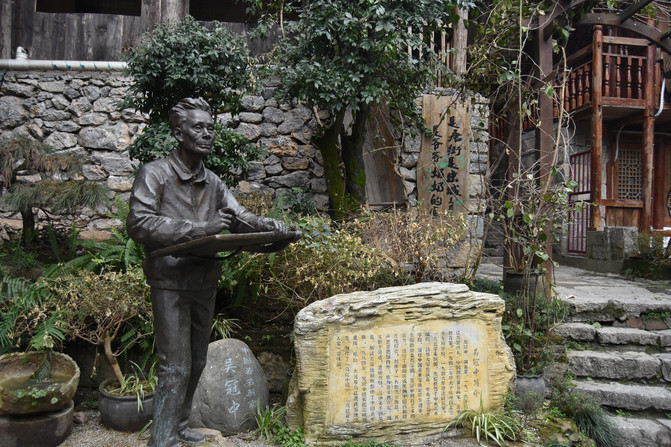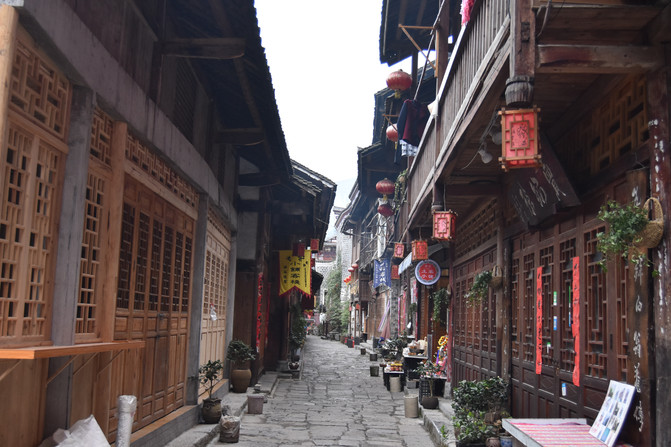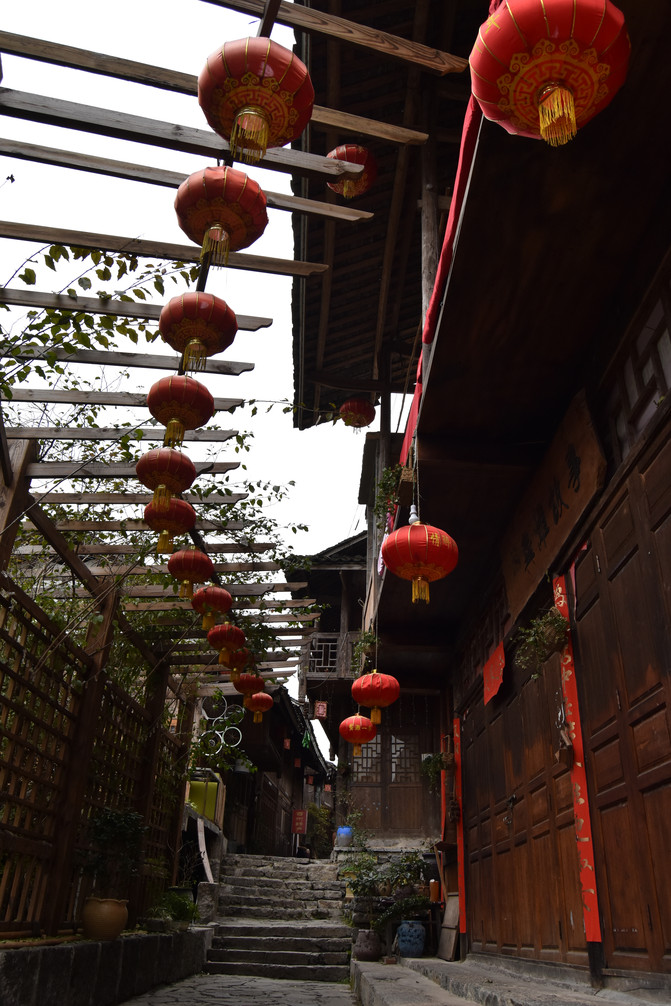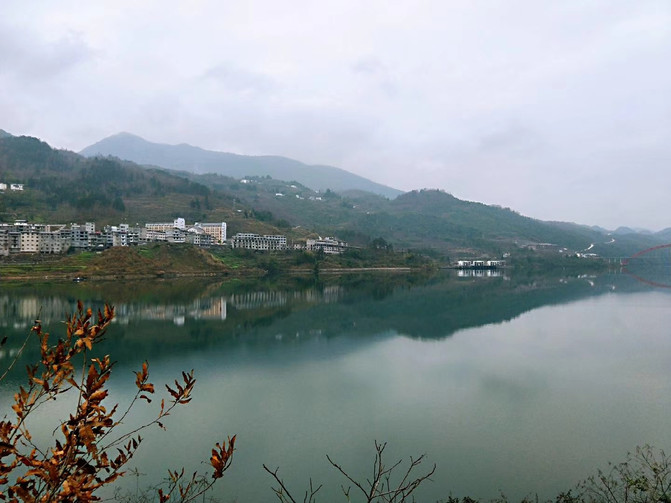One of the self driving trips home for the Chinese New Year - Qionglou Linshui Gongtan Town

[Preface]
After retiring, my parents settled in Chengdu and went back home to visit them during the Spring Festival. I didn't want to rush to catch up with the Spring Festival travel rush, so I decided to drive home a few days early and visit the beautiful mountains and rivers of our country. I designed a self driving route from Shandong to Sichuan, with the southern route going to the northern route without going back.

Regarding the itinerary
Self driving route: Dongying Jingzhou Chongqing Gongtan Ancient Town Zigong Sichuan Emeishan Chengdu Hanzhong Qingmuchuan Luoyang Dongying.
D1 January 30 Dongying Jingmen (1100 kilometers, 13 hours)
Accommodation at Jingmen Wuji Hotel
On January 31st, from Jingmen to Gongtan Ancient Town in Youyang (800 kilometers, 11 hours)
Accommodation at Dong's Inn in Gongtan Ancient Town
Tasting Wujiang fish, Gongtan roasted pork belly, and mung bean flour
D3 February 1st, from Gongtan Ancient Town in Youyang to Zigong (550 kilometers, 8 hours) Lantern Park
Accommodation Comfort 158 Chain Hotel (Zigong Wuxing Street Branch) (formerly Denghui Branch)
On February 2nd, from Zigong to Mount Emei (160 kilometers, 2 hours)
Accommodation in Emei Mountain Scenic Building
D5 February 3rd Emei Mountain to Chengdu (160 kilometers, 2 hours) Chengdu Street Photography
D6 New Year's Eve in Xindu
D7 February 5th, New City Manhua Manor
D8 February 6th, 2nd day, Huaiyuan and Yuantong ancient towns
D9, February 7th, 3rd, Baoguang Temple in Xindu
D10 February 8th, 4th, from Xindu to Aokigawa (320 kilometers, 4.5 hours)
Accommodation at Ningqiang Qingmuchuan Jinshi Hotel
D11: On the fifth day of February 9th, from Aoki River to Luoyi Ancient City (830 kilometers, 12 hours)
Accommodation at Boyang Business Hotel in Luoyi Ancient City
D12 February 10th 6th Luoyang to Dongying (800 kilometers, 8 hours) Luoyi Ancient City

Qionglou Linshui Gongtan Town
We are heading home for the Chinese New Year and taking a nap at the Heze service area during lunchtime. Although the weather forecast seems to be rainy and snowy these days, driving home is much happier than those who ride motorcycles home.

The heavy snow is flying outside the car, and the sky and earth are vast. The wanderers are eager to return home, praying for everyone's safety.

Braved the rain and snow, accompanied by the night, arrived at Jingmen. Staying at a seasonal hotel in the city, having dinner nearby, and resting.


Hubei is too early to eat Hot dry noodles.

Leaving Jingmen, known as the gateway to Jingchu, in the early morning, passing through the Shanghai Chengdu and Shanghai Chongqing highways, heading towards the millennium cultural ancient town of Gongtan. Along the way, Bashan and Shushui accompanied each other, shrouded in mist and clouds, and beautiful beyond measure.




Walking through the Shanghai Chongqing Expressway, the sky is filled with clouds and mist. The mountains are now hidden, like a heavenly path in a fairyland.


Last night, the north wind blew snow,
The mountains are covered in silver.
Natural Danqing Painting,
Suspected to be in the northern region.

There are four seasons along the way, with different days for a hundred miles.

In the evening, we arrived at Gongtan Ancient Town. Between the towering mountains of Chongqing and Guizhou, the Wujiang River and the Apeng River meandered and intersected like two giant dragons in Youyang Tujia and Miao Autonomous County, forming a dangerous shoal with fast flowing water. Due to the fact that many families surnamed Gong lived on the shore, it was named Gongtan.


Gongtan is not just about mountains and canyons, treacherous rapids and rivers. It also boasts the largest cluster of stilted houses in Asia, the charming Wujiang Gallery, the famous stone street, the remnants of salt culture, and the bold and cheerful character of the Tujia ethnic group.



In 1984, the famous painter Wu Guanzhong referred to Gongtan as "Tang Street, Song City, and the home of grandparents". The ancient Gongtan remains in the depths of memory, and after relocation, Gongtan presents a new scene.

Nowadays, Gongtan Ancient Town no longer has the bustling passersby of the ancient salt road in Sichuan and Guizhou, and is gradually becoming calm. But the old stone slab street and the hanging "salt lanterns" of the stilted buildings still tell the story of the former prosperity of the ancient town.


The ancient town inn where I stayed at night has an elegant style that complements the millennium old town. Living in a room by the river, you can enjoy the scenery of the Wujiang River and the ancient town from the balcony.





Of course, Wujiang fish and Gongtan's braised pork belly are definitely not to be missed.


As night falls, the ancient town fades away from the hustle and bustle of the day. At night, the ancient town is peaceful and beautiful, and you can faintly hear the sound of the watchman banging on the clapper, suddenly returning to a thousand years ago.








Strolling through the ancient town in the morning
The Most Beautiful Ancient Town Time
Dusted away in the dust that cleanses the soul
There is a timeless history
Engraved in the ancient and long years
People chase lightly
Chasing the clouds and water scattered on the bluestone board, passing by
Chasing the fleeting memories forgotten in ordinary alleys
Perhaps this is called 'peaceful time'.


Entering Gongtan is like entering a landscape painting with freehand brushwork and ink splatter. Gongtan is a canyon ancient town achieved by mountains and floods, with a history of nearly 1800 years.

Gongtan Ancient Town originated in Shu Han and is located at the foot of Fenghuang Mountain at the confluence of the Apeng River and the Wujiang River. It is the junction of Youyang County, Pengshui County, Chongqing, and Yanhe County, Guizhou Province, surrounded by river valley landforms. The ancient town was built along the riverbank mountains.

A mountain collapse changed Gongtan. Before the mid Ming Dynasty, Gongtan was just an inconspicuous small place on the Wujiang River. But in the early years of the Wanli reign of the Ming Dynasty, the Fenghuangling cliff where Gongtan was located collapsed, and huge stones fell into the river, blocking the Wujiang waterway. The water depth of the Wujiang River in the Gongtan section became shallower, and ships had to unload their goods at Gongtan, and then empty boats were pulled across the dangerous shoals, or they could only continue to move forward after landing. The prosperity of Gongtan lasted from the Wanli period of the Ming Dynasty to the Republican era

Due to significant geological and hydrological changes, Gongtan has become an important town along the Fulan River of the Sichuan Salt Ancient Road. It serves as a transit station for passengers and goods from Sichuan (Chongqing), Guizhou, Hunan, and Hubei provinces. Yangtze River water transportation can enter the Wujiang River through Fuling and reach Gongtan. From Gongtan to the east, it can be transported by short distance land transportation to Longtan Ancient Town in Youyang for further transportation on the eastern route. From Gongtan, it can also be transported southward to the Sinan area of Guizhou. Gongtan has gradually evolved into a hub for goods distribution and commercial prosperity.


During the Republic of China period, the highway tunnel built by Gongtan also realized the transportation of goods by road. Gongtan, located on a transportation hub, has a thousand year old Tujia culture as its foundation and water transportation as its momentum, accepting and accommodating wealthy merchants and tycoons from all over the world. Even HSBC has a branch in Gongtan.

During the peak period of the ancient town, Gongtan Port had an annual cargo throughput of over 5 million tons, making it an important distribution center for commodities such as salt, cloth, and tung oil.
The name 'Qian Gong Tan' comes from this, "said Wang Shenghua." Qian Gong Tan 'actually refers to the opportunity to make money brought by the location and prosperity of Gong Tan.

The bustling trading and flowing crowds have also driven the expansion of Gongtan Ancient Town, leaving behind unique buildings that stretch for two kilometers from the upper dock to the lower dock.


These residential buildings nestled by mountains and waters are all made of pure wooden structures suspended in the air, with unique designs. Rows of perforated houses and suspended buildings still exude a "barbaric" flavor and ancient style.


In 1984, the famous painter Wu Guanzhong went to Gongtan to create and called Gongtan "Tang Street, Song City, and the home of grandparents". This statement is a prosperous representation of Gongtan's history, awakening people's deep-seated nostalgia.


Although Gongtan Old Street was submerged during the construction of the hydropower station in 2005, the wooden stilted houses along the riverbank of the old street had been relocated to Xiaoyintan, 1.5 kilometers away from the original site. Although the scale is slightly smaller than the original old street, the essence of Gongtan Ancient Town has been relocated and preserved.

Although the ancient town has been rebuilt, the stone carvings, inscriptions, and polished marks on the real objects of the old street still convey a strong sense of historical vicissitudes. After the relocation of Gongtan, the original sequence and layout of the stilted houses and courtyard houses have not changed significantly. The original neighbors remain neighbors after the relocation, and many houses have changed from warehouses and inns to restaurants and homestays. However, life in the ancient town remains peaceful and simple.


Tan Ancient Town, nestled by mountains and waters, boasts unique natural conditions where you can experience a different kind of life. That kind of peaceful life without any hint of fireworks. Gongtan Ancient Town has stood here for over 1800 years, and I think it's probably just waiting for you.

The Qingshan Stone Street in Gongtan Ancient Town is as serene as jade, connecting the whole town. Along the street are ancient and towering wooden hanging buildings facing the cliffs.

In terms of facilities and reception, Qianjia in the ancient town is a tradition that has been overlooked. Among the accommodations, there is also a feeling of refreshing breeze and moon gazing, and listening to the tide by the river.


From Gongtan to Zigong, passing by "Wujiang Gallery", the section from Gongtan to Wanmu, the main stream of Wujiang River, has a total length of more than 60 kilometers, including two ancient towns of Gongtan and Qingquan, and the section from Gongtan to Dahekou, the first level tributary of Wujiang River, which can be called the essence of Wujiang Gallery. On both sides of the strait, lush greenery surrounds the mountains, with towering peaks facing each other, each displaying a divine presence.


Previous Article:Spring outing, soaking in hot springs, praying for blessings in Jinfo Mountain, flying kites, and spending a fun and beautiful weekend like this!
Next Article:A great place to go during the Spring Festival holiday, check in at the amusement park on the cliff of Wushan
